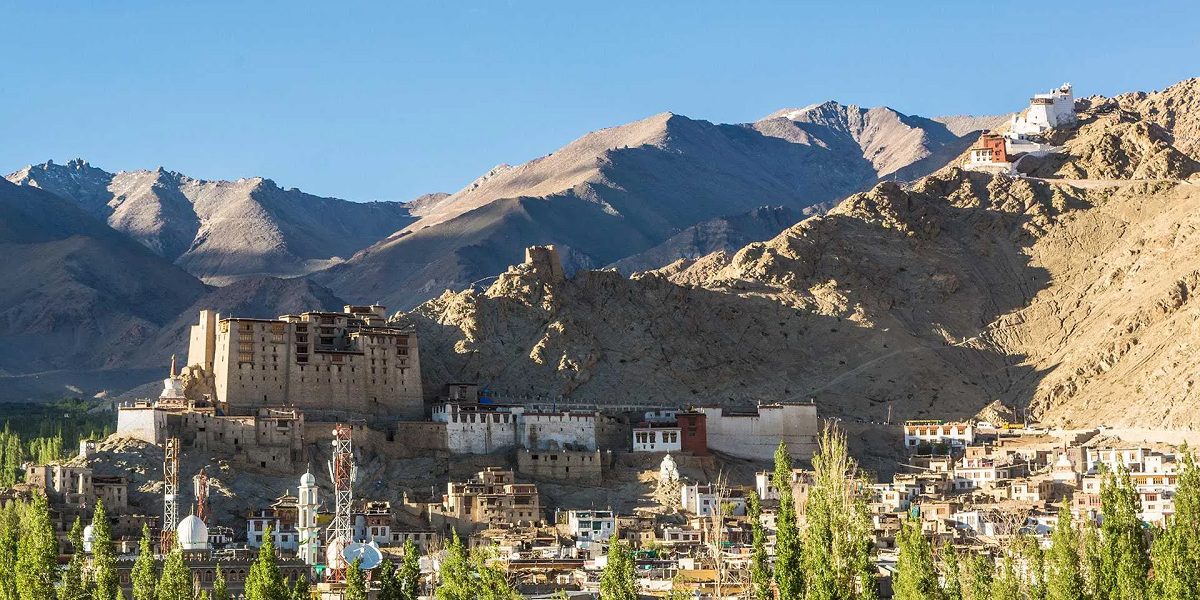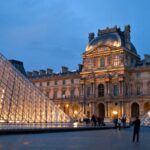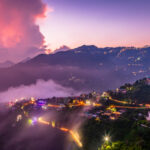Welcome to Leh, the breathtaking paradise nestled in the lap of the Himalayas. If you’re planning a trip to this enchanting destination, you’re in for a treat! Leh offers a plethora of experiences that cater to every type of traveler, from adventure enthusiasts to culture aficionados. In this guide, we’ll unveil the top 30 things to do in Leh, ensuring you make the most of your visit to this captivating region.
Things To Do In Leh
- Conquer the Mighty Khardung La Pass:
Kickstart your Leh adventure by conquering the world’s highest motorable pass, Khardung La. Situated at an altitude of 5,359 meters, this iconic pass offers spellbinding views of the snow-capped peaks and dramatic landscapes. Whether you’re a thrill-seeker or a photography enthusiast, a journey to Khardung La promises an unforgettable experience.
- Marvel at the Leh Palace:
Step back in time and immerse yourself in the rich history of Leh by visiting the magnificent Leh Palace. Built in the 17th century, this historic palace offers panoramic views of the Leh Valley and the Stok Kangri range. Explore the ancient architecture, royal chambers, and vibrant murals that depict the tales of Leh’s glorious past.
- Discover the Monastic Marvels:
Leh is home to some of the most revered monasteries in the Himalayas, each offering a serene retreat for spiritual seekers. Make sure to visit the iconic Thiksey Monastery, Hemis Monastery, and Diskit Monastery to witness the unique blend of Tibetan Buddhist culture and architecture.
- Embark on a Trekking Expedition:
Calling all adventure enthusiasts! Leh is a paradise for trekking aficionados, with an array of trails catering to all skill levels. Whether you’re a novice or a seasoned trekker, embark on an exhilarating journey through the picturesque landscapes of the Markha Valley, Stok Kangri, or the famed Chadar Trek.
- Experience the Magic of Pangong Lake:
Prepare to be mesmerized by the ethereal beauty of Pangong Lake, one of the highest saltwater lakes in the world. Located at an altitude of 4,350 meters, this azure gem stretches across the Indo-China border, offering surreal vistas that change hues with the shifting sunlight.
- Witness the Magnetic Hill Phenomenon:
Indulge in the mystique of Leh’s Magnetic Hill, where the laws of gravity seem to defy logic. Experience the thrill of your vehicle being pulled uphill, seemingly on its own, amidst the backdrop of stunning Himalayan scenery. Don’t forget to capture this optical illusion on camera!
- Shop for Souvenirs at the Leh Market:
Immerse yourself in the vibrant local culture by exploring the bustling markets of Leh. From colorful handicrafts and traditional attire to exquisite Tibetan artifacts and souvenirs, the Leh Market is a treasure trove for avid shoppers and culture enthusiasts alike.
- Sample Local Cuisine:
No trip to Leh is complete without savoring the delectable flavors of Ladakhi cuisine. Indulge your taste buds with mouthwatering delicacies such as Thukpa, Momos, Butter Tea, and Apricot Jam, served with warm Ladakhi hospitality at local eateries and cafes.
- Attend a Cultural Festival:
Immerse yourself in the vibrant cultural tapestry of Leh by attending one of its lively festivals. From the grand Hemis Festival celebrating Tibetan Buddhism to the colorful Ladakh Festival showcasing the region’s rich heritage, these cultural extravaganzas offer a glimpse into the soul of Leh.
- Stargaze in the Tranquil Night Sky:
End your day on a celestial note by stargazing amidst Leh’s unpolluted skies. With minimal light pollution and clear atmospheric conditions, Leh offers unparalleled opportunities to witness the mesmerizing beauty of the night sky, adorned with shimmering stars and celestial wonders.
- Explore the Enigmatic Nubra Valley:
Venture into the surreal landscapes of Nubra Valley, a hidden gem nestled amidst towering mountains and lush greenery. Marvel at the stark contrast between the desert-like terrain and the vibrant oasis of Diskit and Hunder villages. Don’t miss the chance to ride a Bactrian camel, known for its distinctive double hump, against the backdrop of towering sand dunes.
- Rafting on the Indus and Zanskar Rivers:
Embark on an adrenaline-pumping rafting expedition on the gushing waters of the mighty Indus and Zanskar rivers. Whether you’re a novice or an experienced rafter, Leh offers thrilling rapids and scenic stretches that promise an exhilarating adventure amidst breathtaking landscapes.
- Visit the Hall of Fame:
Pay tribute to the brave soldiers who sacrificed their lives to protect the nation by visiting the Hall of Fame, a museum and memorial dedicated to the Indian Army’s valiant efforts in the region. Explore the exhibits showcasing military artifacts, weapons, and stories of heroism, offering insights into the region’s tumultuous history.
- Attend a Meditation Retreat:
Immerse yourself in the serenity of Leh’s tranquil surroundings by participating in a meditation retreat or yoga session. With its pristine air and spiritual ambiance, Leh provides the perfect setting to rejuvenate your mind, body, and soul amidst the majestic Himalayas.
- Discover Ancient Rock Carvings:
Uncover the mysteries of Leh’s ancient past by exploring the fascinating rock carvings and petroglyphs scattered across the region. Dating back thousands of years, these intricate carvings depict scenes of daily life, religious rituals, and mythical figures, offering a glimpse into the region’s rich cultural heritage.
- Birdwatching at Tso Moriri Lake:
Embark on a birdwatching excursion at Tso Moriri Lake, a serene high-altitude lake nestled amidst the Changthang Plateau. Home to a diverse array of avian species, including bar-headed geese, Brahminy ducks, and black-necked cranes, this pristine sanctuary offers birdwatchers and nature enthusiasts a glimpse into the region’s rich biodiversity.
- Discover the Ancient Trade Route of Silk Route:
Trace the historic Silk Route, an ancient trade route that connected Leh with Central Asia, China, and beyond. Explore the remnants of ancient caravanserais, trading posts, and centuries-old monasteries that once thrived along this fabled route, offering insights into the region’s vibrant cultural exchange and economic prosperity.
- Photography Expedition:
Capture the ethereal beauty of Leh’s landscapes, architecture, and vibrant culture through the lens of your camera. Whether you’re a professional photographer or a passionate amateur, Leh offers endless opportunities for capturing breathtaking shots of snow-capped peaks, pristine lakes, colorful prayer flags, and traditional Ladakhi architecture.
- Explore Hidden Gems:
Venture off the beaten path and discover Leh’s hidden gems, including remote villages, pristine valleys, and secluded monasteries. Embark on a jeep safari or trek to lesser-known destinations such as Turtuk, Lamayuru, and Alchi, where you can immerse yourself in the untouched beauty and tranquility of the Himalayan wilderness.
- Volunteer for Community Initiatives:
Make a positive impact on the local community by participating in volunteer projects and community initiatives in Leh. Whether it’s teaching English to local children, participating in environmental conservation efforts, or supporting sustainable tourism initiatives, volunteering offers a meaningful way to connect with the local culture and give back to the community.
- Experience a Homestay with Local Families:
Immerse yourself in the warmth of Ladakhi hospitality by staying with local families in traditional homestays. Experience the authentic way of life in remote villages such as Stok, Uleytokpo, or Likir, where you can partake in daily chores, share meals with your hosts, and learn about their unique customs and traditions.
- Attend a Traditional Cultural Show:
Enrich your cultural experience in Leh by attending a traditional Ladakhi cultural show. Witness captivating performances of folk dances, music, and theatrical presentations showcasing the region’s rich heritage and age-old traditions. Don’t miss the opportunity to interact with local artists and learn about the significance of each performance.
- Explore the Ancient Monastic Route:
Embark on a spiritual journey along the ancient Monastic Route, a network of ancient pathways that connect the region’s most revered monasteries. Trek through picturesque landscapes, visit remote monastic hermitages, and immerse yourself in the peaceful ambiance of sacred sites such as Lamayuru, Phyang, and Likir.
- Attend a Cooking Workshop:
Delve into the flavors of Ladakhi cuisine by participating in a traditional cooking workshop. Learn the art of preparing authentic dishes such as Skyu (Ladakhi noodle soup), Chutagi (buckwheat pancakes), and Apricot Chicken under the guidance of local chefs. Enjoy a hands-on culinary experience and savor the delicious creations afterward.
- Embark on a Wildlife Safari:
Embark on an unforgettable wildlife safari in the rugged landscapes of Ladakh, home to a diverse array of flora and fauna. Keep your eyes peeled for rare Himalayan wildlife such as snow leopards, Tibetan wolves, blue sheep, and golden eagles as you explore the region’s pristine national parks and wildlife sanctuaries.
- Explore the Ruins of Basgo:
Step back in time and explore the ancient ruins of Basgo, a historic fortress and monastery complex dating back to the 15th century. Marvel at the intricate architecture, crumbling ramparts, and ornate Buddhist murals that adorn the walls of this UNESCO World Heritage Site, offering a glimpse into Leh’s storied past.
- Discover Traditional Ladakhi Handicrafts:
Indulge in a shopping spree and discover the rich tapestry of Ladakhi handicrafts at local markets and artisan workshops. Browse through exquisite handwoven textiles, intricately crafted silver jewelry, vibrant thangka paintings, and handmade pottery, each reflecting the region’s artistic heritage and cultural identity.
- Go Mountain Biking:
Satisfy your adrenaline cravings by embarking on an exhilarating mountain biking adventure through Leh’s rugged terrain. Whether you’re tackling challenging mountain trails or leisurely cycling along scenic routes, Leh offers endless opportunities for adrenaline-pumping rides amidst breathtaking Himalayan vistas.
- Experience a Traditional Archery Competition:
Witness the age-old tradition of archery come to life by attending a traditional archery competition in Leh. Cheer on the local archers as they showcase their skills and precision in this ancient sport, accompanied by festive music, colorful attire, and jubilant celebrations.
- Relax with a Hot Stone Bath:
Unwind and rejuvenate your body and soul with a traditional Ladakhi hot stone bath, known for its therapeutic benefits. Immerse yourself in a wooden tub filled with hot water and aromatic herbs, while heated stones are placed strategically to soothe tired muscles and promote relaxation, offering a blissful respite from your adventures in Leh.
Conclusion:
Leh, with its unparalleled natural beauty, rich cultural heritage, and adrenaline-pumping adventures, promises an unforgettable journey for every traveler. Whether you’re seeking adventure, spiritual solace, or simply a rendezvous with nature, Leh has something magical in store for you. Embark on a transformative voyage to this Himalayan haven and create memories that will last a lifetime. Start planning your Leh escapade today and unlock the treasures of this enchanting land!




